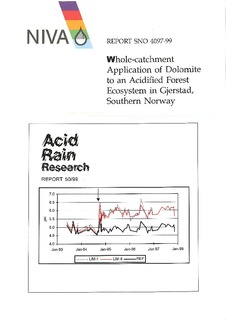| dc.contributor.author | Hindar, A. | nb_NO |
| dc.contributor.author | Norgaard, E. | nb_NO |
| dc.contributor.author | Nilsen, P. | nb_NO |
| dc.contributor.author | Høgberget, R. | nb_NO |
| dc.contributor.author | Wright, R. | nb_NO |
| dc.contributor.other | Hindar, A. - Project manager | nb_NO |
| dc.coverage.spatial | Aust-Agder | nb_NO |
| dc.date.accessioned | 2014-08-01T10:44:12Z | |
| dc.date.available | 2014-08-01T10:44:12Z | |
| dc.date.issued | 1999 | nb_NO |
| dc.identifier | 4097 | nb_NO |
| dc.identifier.isbn | 82-577-3705-4 | nb_NO |
| dc.identifier.issn | 1894-7948 | nb_NO |
| dc.identifier.uri | http://hdl.handle.net/11250/210517 | |
| dc.description.abstract | As part of the research programme "Counteractions Against Acidification in Forest Ecosystems" (Miljøtiltak i skog), a coniferous-forested catchment was limed with dolomite in September 1994. 3 t ha¹ of coarse dolomite powder were spread on 0.8 km² by helicopter. The liming resulted in an immediate improvement in runoff water quality relative to an adjacent refernce catchment. pH, Ca, Mg and ANC (acid neutralising capacity) increased and inorganic Al decreased. Favourable water quality was maintained for 3 years. NO³-concentrations increased the second year after liming, whereas concentrations of total N and TOC were not significantly changed. Liming did not affect concentrations of 7 trace metals (As, Cd, Cu, Fe, Ni, Pb, Zn) whereas concentrations of Mn, Co, and Zn decreased. Only minor changes in soil solution, and only at some of the lysimeters were detected. Steep slopes, thin soils, high amounts of precipitation and thus dominance of surface and subsurface flow in this catchment may explain the rapid response in runoff. During the first three years after liming there have been no sigificant effects on tree growth and vitality (crown density and crown colour). This experiment shows that liming of forested catchments is a viable method to obtain long-term improvement in water quality and positive effects for acidsensitive aquatic organisms. | nb_NO |
| dc.description.sponsorship | Norwegian Ministry of Agriculture Norwegian Ministry of Environment, the counties of Rogaland Vest-Agder, Aust-Agder and Telemark Norsk institutt for vannforskning (NIVA) | nb_NO |
| dc.publisher | Norsk institutt for vannforskning | nb_NO |
| dc.relation.ispartofseries | NIVA-rapport;4097 | nb_NO |
| dc.rights | Navngivelse-IkkeKommersiell-DelPåSammeVilkår 3.0 Norge | nb_NO |
| dc.rights.uri | http://creativecommons.org/licenses/by-nc-sa/3.0/no/ | nb_NO |
| dc.subject | kalking | nb_NO |
| dc.title | Whole-catchment Application of Dolomite to an Acidified Forest Ecosystem in Gjerstad, Southern Norway | nb_NO |
| dc.type | Research report | nb_NO |
| dc.rights.holder | Norsk institutt for vannforskning/Norwegian institute for water research | nb_NO |
| dc.subject.nsi | VDP::Matematikk og naturvitenskap: 400 | nb_NO |
| dc.subject.keyword | skog | nb_NO |
| dc.subject.keyword | forsuring | nb_NO |
| dc.subject.keyword | kalking | nb_NO |
| dc.subject.keyword | vannkvalitet | nb_NO |
| dc.subject.keyword | water quality | nb_NO |
| dc.subject.keyword | forest | nb_NO |
| dc.subject.keyword | acidification | nb_NO |
| dc.subject.keyword | liming | nb_NO |
| dc.relation.project | E-98425 | nb_NO |


